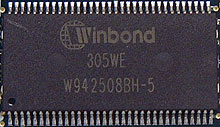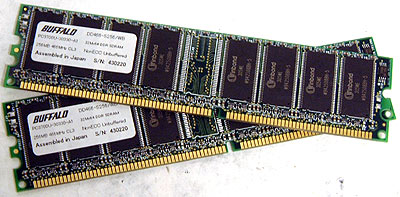As a performance enthusiast,
I know that the search for the "ultimate" overclocker memory is a never ending battle. While we've been happily testing away with Corsair XMS3500 CAS2 memory modules
for the last little while, we've always kept our eyes open for even more
overclockable memory modules.
Buffalo Technology is not a newcomer to the
memory market, they've been manufacturing and selling memory for the last 15
years. While the big guns of Kingston, Mushkin and Corsair only have PC3200/3500
rated memory in their lineup and OCZ and GeIL recently announcing PC3700 DDR, we
were surprised to receive some PC3700 DIMM's from Buffalo Tech for
testing.
With a
PC3700 (DDR466 at CL3) speed rating the Buffalo memory is easily the fastest
rated memory we've tested to date at the PCstats labs. Whether the memory can
actually reach those speeds is another
question, but we'll soon find out!
What's
even more surprising is the retail price of the memory! Amazingly two
sticks of 256MB Buffalo PC3700 memory can be had for just $194 CDN ($130 US)!
That's about $75 CDN cheaper then then two sticks of 256MB Corsair XMS3500 CAS2
and about $120 CDN cheaper then two sticks of 256MB OCZ PC3700 DIMM's! Getting
back to the real world now though, value and overclocking usually mix like oil
and water and we have not had much luck with value memory in the
past. We were certainly hoping our experiences would be different this time around with the
Buffalo PC3700 memory.
A familiar face...
 While the DRAM is only rated to run at 200
MHz FSB (1000MHz / 5 = 200 MHz), we were not surprised to
see Buffalo decided to go with Winbond BH-5 DRAM for their PC3700 modules. After
all, Corsair uses the Winbond BH-5 DRAM on their XMS3500 CAS2 DIMM's and
we have no problems pushing them to PC3700 speeds on our reference Epox 8RGA+
or Abit IT7 MAX2 Rev2 motherboards.
While the DRAM is only rated to run at 200
MHz FSB (1000MHz / 5 = 200 MHz), we were not surprised to
see Buffalo decided to go with Winbond BH-5 DRAM for their PC3700 modules. After
all, Corsair uses the Winbond BH-5 DRAM on their XMS3500 CAS2 DIMM's and
we have no problems pushing them to PC3700 speeds on our reference Epox 8RGA+
or Abit IT7 MAX2 Rev2 motherboards.
Buffalo
forgoes memory heat spreaders that are usually found on
most performance memory modules. Since RAMsinks for DDR memory are really only
for show, this is not really a bad move on their part and in the end it saves
the user a bit of money.
Since the Buffalo memory has a PC3700 rating (albeit at CL3) we had
some high hopes as the first module of memory was installed into our reference Epox 8RGA+ testing
motherboard. The FSB was immediately raised to 200 MHz while maintaining the most
aggressive memory timings.
Not surprisingly the Buffalo PC3700 managed
those speeds without even breaking a sweat. We next bumped the memory up
to 210 MHz and that was when we began to have a few stability problems. Luckily
that was nothing a slight memory voltage increase (raised memory voltage to
2.77V) couldn't fix.
At around
214 MHz we again had a few stability problems with 3DMark2001SE and had to up
the memory voltage to 2.9V. Unfortunately our overclocking adventures on the AMD
test rig maxed out at 215 MHz FSB, but we were using the most
aggressive settings of 2-2-2-5. Using SPD timings (3-4-4-8) we were able to push
the memory all the way up to 225 MHz while keeping the system 100% stable. Of
course because of the lower timings, performance at 225 MHz was worse then at 215 MHz
FSB with the most aggressive timings. Not quite able to hit the PC3700
rating but (DDR466 which means 233 MHz FSB) but very close! Oh I think this
is a worthy note, officially these DIMM's are not meant for "Dual Channel", but still
they worked flawlessly together.

Because we didn't hit PC3700 speeds with our AMD test system, we were
hoping to get some better results with our Intel test system. With a P4 1.6A and
the 3/4 memory divider enabled, we began to raise the FSB. We easily broke the 200
MHz memory frequency mark (150 MHz FSB).
At around 210 MHz we ran into a few stability problems and
had to raise the memory voltage to 2.8V to help stabilize things. We hit the
wall at 220 MHz memory speed (165 MHz FSB),
no matter what we did we just could not get the system go higher and increasing
the voltage did not help at all.
A quick explanation on testing
methods...
In the last little while we've gotten a
few comments on our memory testing methods. Mainly, some out there seem to think that
we should run the memory frequency async on the nForce2
platforms (faster then the FSB) so we can run the memory at their "native"
speed. It's funny how quickly people forget, it's common knowledge that nForce2
performs best when the FSB and memory are running at the same
speed. Here are a few numbers for those disbelievers out there.
;-)
Keeping the memory timings the same
(2-2-2-5) and running 3DMark2001SE, at 166/333 (sync) we score 16113 while at
166/400 (async) we get just 15758. A loss of around 400 points
despite the availability of more bandwidth to the system. Wait, there's more!
With Quake III Arena, in its fastest mode the system running 166/333 (sync) gets
378.3 fps while 166/400 (async) gets 358.2 fps.
We here at PCStats always test for best performance and we
will continue running our memory in sync
with the FSB as long
as we're using a nForce2 testing platform.

